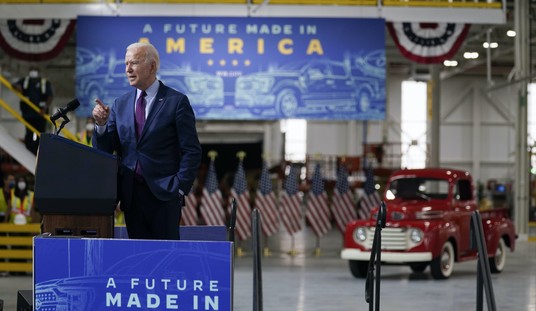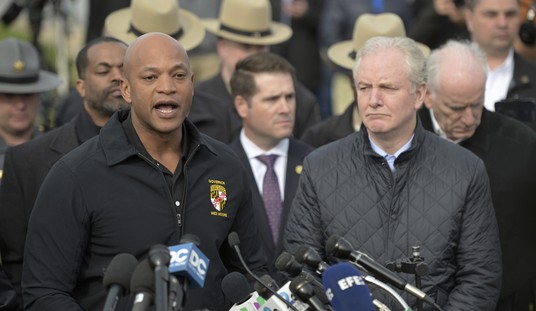Worrisome, but not surprising. Even with good intelligence, how could they possibly know where every last sarin shell is stashed away?
The real news here is that Assad keeps moving his weapons around — which, if your memory extends to several months ago (“a long time”!), you’ll recognize as a violation of Obama’s initial “red line” last year. (“[A] red line for us is, we start seeing a whole bunch of weapons moving around or being utilized.”) Those goalposts have moved a lot since then.
The judgment comes from top U.S. military commanders and is supported by recent intelligence community assessments, according to three U.S. officials who work closely on Syrian intelligence matters. At the heart of the concern is that the Syrian military has transferred more and more of its stock of sarin and mustard gas from storage sites to trucks where they are being moved around the country. While U.S. intelligence agencies first saw reports that Syria was moving the weapons last year, the process has accelerated since December, according to these officials. Also worrisome, said two of the officials, is intelligence from late last year that says the Syrian Scientific Research Center—an entity responsible for Syria’s chemical-weapons stockpile—has begun to train irregular militias loyal to Syrian President Bashar al-Assad in how to use the chemical munitions.
The assessment that Syria is moving large amounts of its chemical weapons around the country on trucks means that if Obama wanted to send in U.S. soldiers to secure Syria’s stockpiles, his top generals and intelligence analysts doubt such a mission would have much success, according to the three officials. “We’ve lost track of lots of this stuff,” one U.S. official told The Daily Beast. “We just don’t know where a lot of it is.”…
One official said U.S. spy satellites in November picked up clear photographic evidence of trucks being loaded at known chemical-weapons storage sites outside Damascus. But this official also said the satellite did not track the movement of the trucks in the country. “You have to remember that satellites are not unmanned aerial vehicles,” this official said. “We saw the trucks being loaded, but we did not see where they went.”
Why weren’t they watching where the trucks went from the beginning, if Obama was supposedly treating movement of chemical weapons as a red line?
The idea of regime goons driving around with WMD in the trunk reminds me of this harrowing Atlantic piece from a few years ago about Pakistan’s military carrying nuclear weapons — live, ready to detonate — in civilian vans over open roads with a light security presence. Why would you do that in a country that’s crawling with jihadist nuts? Because: Their fear of U.S. troops swooping in and capturing the weapons if they kept them stored in known depots is, insanely, greater than their fear of terrorists ambushing a van and grabbing what’s inside. The subterfuge of moving them around in civilian vehicles is aimed mainly at fooling Uncle Sam’s eye in the sky, not Al Qaeda’s eyes on the ground. Assad’s running the same risk, it sounds like. Not hard to magine a gang of rebels ambushing a truck with an eye to stealing supplies and stumbling on a cache of sarin — which, ironically, raises an element of doubt that Assad’s really responsible for all of the alleged chemical attacks thus far. If WMD is kinda sorta “loose” on the open road, who’s to say that the rebels haven’t already gotten hold of a bit?
So, let’s game this out. Imagine the U.S. or Jordan, backed by the U.S., sends in troops covertly to grab whatever chemical weapons they can from the depots they still know about. Imagine they’re 100 percent successful. There are still plenty of chemical weapons out there somewhere, and Assad will probably feel compelled to respond to the U.S. incursion. If you’re the White House and you’re worried about him retaliating by tasking one of those “irregular militias” to gas a few hundred people in Aleppo or Homs, what’s your next move? Almost necessarily, you need to be prepared to take a next step if/when Assad acts. Hopefully he’ll realize that and be deterred from retaliating, but maybe he’ll decide, with Iranian backing, to call your bluff. What’s the next step then? A no-fly zone? Hmmmm:
Harmer contends that a no-fly zone wouldn’t have to become a foreign-provided Free Syrian Air Force: U.S. pilots won’t have to provide close-air support for rebel forces or bomb ground targets. But from Harmer’s perspective, once Assad’s air power is blunted, “the only solution left is a negotiated conclusion, or, more likely, a fallback to the Alawite coastal areas.” In other words, the Assad regime as we know it is over.
It’s an optimistic assessment: many, many analysts have considered airpower the key to breaking an enemy’s will, and many analysts have been refuted. It’s possible — but it depends on Assad suing for peace, not a suddenly invincible Syrian rebel force on the ground. And its risks are substantial: not least of which, it would mean American pilots shooting down Iranian resupply planes, an act of war. “I don’t envy President Obama’s decision,” Harmer says…
Lurking in the background: should Obama Americanize the war in the air, and it fails to topple Assad, how will he avoid pressure to use ground troops?
Thanks to Russia, Syria’s air defenses are vastly better than Libya’s. And as noted by Danger Room, shooting down Iranian planes opens the conflict up in all sorts of ways. Just for starters, western negotiations with Iran over its nuclear program would be instantly dead — not a disaster, given that they’ve been a charade all along, but a major crisis for the White House and Europeans who’ve been using those negotiations to kick the Iran can down the road. Then it would be Iran’s turn to retaliate — maybe against U.S. troops in Afghanistan via proxies or against Israel by mobilizing Hezbollah, maybe against other American assets internationally with terror strikes, maybe even by quietly launching its own chemical attacks in Syria to show that America’s big WMD clampdown backfired spectacularly. See why O is so hesitant to enforce his red line? Unless the “next step” he’s prepared succeeds in scaring Assad into not using the rest of his WMD arsenal, any initial military intervention is likely to drag the U.S. from confiscating WMD into moving more aggressively for regime change. Which could take years.
Update: This is not a political winner for Obama either. At least, not at the moment:
Only 10 percent of those surveyed in the online poll said the United States should intervene in the fighting. Sixty-one percent opposed getting involved.
But the figure favoring intervention rises to 27 percent if the Damascus government uses chemical weapons, while 44 percent would remain opposed.
Update: Here’s Martin Dempsey explaining why a no-fly zone over Syria wouldn’t be the turkey shoot that it was in Libya.








Join the conversation as a VIP Member